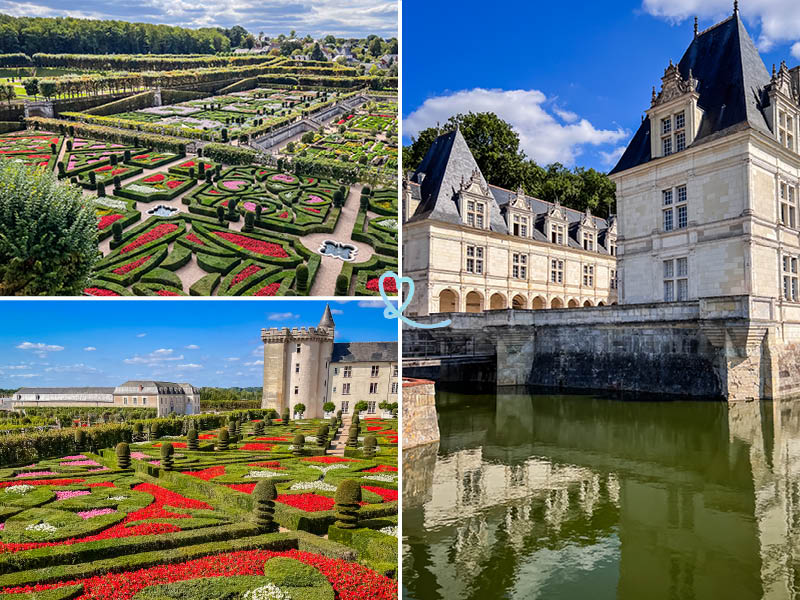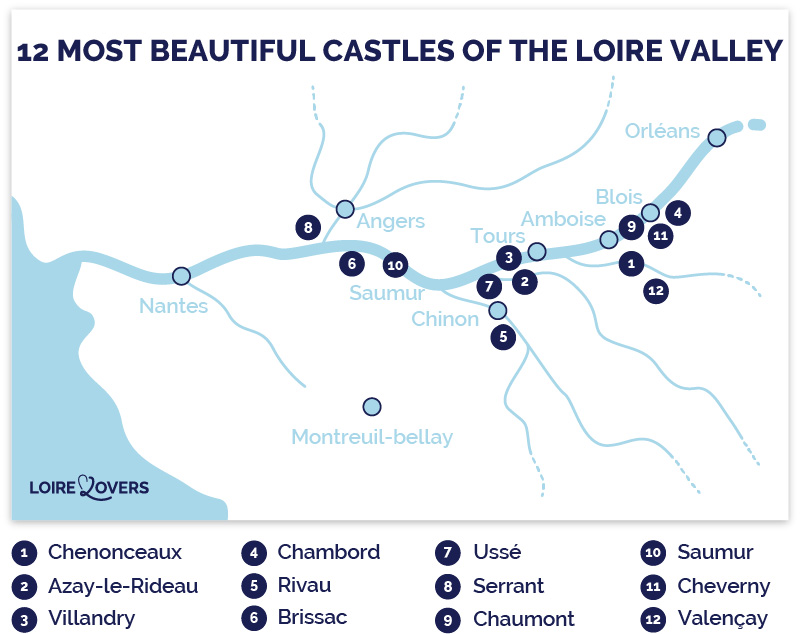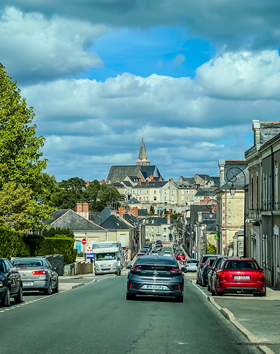Marvel at the Château de Villandry and its extraordinary gardens!
A true jewel of the Loire Valley, this estate will surprise you with its intertwining gardens, breathtaking views and atypical château!
In this article, discover our useful tips in pictures for visiting the Château de Villandry and having a wonderful time!

This guide is completely independent, based on our experiences. We visited the region anonymously, making our own choices and paying our bills in full.
Why visit Villandry's Castle?
Is the castle worth it? Our opinion:
Of course! First and foremost, the château is a must-see for all garden enthusiasts! In our opinion, the magic of Villandry is thebalance between inside and outside. The architecture of the gardens matches that of the château, so that wherever you are, the view is exceptional!
The château is also worth a visit for its pure architecture, which makes it unique in the region. As the last Renaissance château in the Loire Valley, history buffs will be keen to appreciate its evolution through the ages, and to discover the unusual decoration of certain rooms.
Finally, among the 103 châteaux of the Loire Valley to visit, it is one of our top 12 most beautiful châteaux! If that's not a strong argument!

Why is the Château de Villandry famous?
The château is renowned above all for the splendor of its garden. What makes it special is that it has been reinvented by Joachim Carvallo influenced by the gardens of medieval Christianity, the geometric parks of the Italian Renaissance and the symbolism of Hispano-Moorish parterres.
You won't be able to resist the shimmering colors and perfect geometry of this formal garden. In fact, we're willing to bet you'll come back with hundreds of photos after your visit!
It's number 1 on our list of the most beautiful gardens in the Loire Valley!

Our favorite moments
What could be more soothing than strolling through the grounds of Villandry and enjoying the sound of birdsong, the harmony of the greens or the trickle of water? We loved our visit as a whole, but here are our top discoveries:
- The château's striking interiors , for all their classical style, are a delight and make it truly unique in the Loire Valley.
- The various areas of the ornamental garden can be admired from the 1st floor.
- Take a slow stroll through the vegetable garden to discover its extreme diversity and let yourself be charmed by its many colors.

WHERE TO STAY IN Tours
In the city center
Enjoy the city, its restaurants and beautiful architecture.
- Hotel Ferdinand - check prices, pictures and availability
- Hôtel du Cygne - check prices, pictures and availability
- Hotel L'Adresse - check prices, pictures and availability

Near the station and around the city center
An early train? Or just a little more peace and quiet? Here are our recommendations:
- Hotel Les Trésorières - 5 stars - check prices, pictures and availability
- Aparthotel Central Parc Tours - check prices, pictures and availability
- Hotel Oceania L'Univers Tours - check prices, pictures and availability

In the countryside around
Looking for a bit of peace and quiet, without straying too far from the city of Tours? Here's our suggestion:
- Hotel Domaine de la Tortinière - 20 min away - check prices, pictures and availability
- Hotel Troglododo - unusual 25min away - check prices, pictures and availability

History in brief
The castle's history dates back to the Middle Ages, when the foundations were laid and the tower still stands today. It is intertwined with that of its gardens, a summary of which can be found here:
Renaissance: Jean Breton, finance secretary to François I, bought the estate and, in 1532, built a château characteristic of the second Renaissance. A century later, the name Villandry was finally adopted.
Classical period: Count Michel-Ange de Castellane, ambassador to King Louis XV, bought the estate in 1754 and transformed the park into a formal garden. The château remained in the family until the French Revolution, when Jérôme Bonaparte, the Emperor's brother, purchased it in 1813. It was then the turn of Pierre-Laurent Hainguerlot, a financier under the Empire, to live at the estate (1814-1897) and transform the garden into an English-style park.

20th century: After four centuries of oscillating between brilliance and the risk of dismantling, the estate was given a new lease of life in 1908. Joachim Carvallo, a Spanish doctor, and his wife Ann Coleman bought the site and devoted their lives to it. They quickly set about redeveloping the Renaissance-style gardens, which were completed 10 years later, in 1918. The estate has been open to the public since 1920, and is now run by great-grandson Henri Carvallo. His work includes the Jardin du Soleil, completed in 2008.

Access and map: Castle of Villandry (Indre-et-Loire)
Where is the castle?
- In the village of Villandry, 3 rue principale
- Driving time from Tours: 25min
- Driving time from Nantes: 2h
- Driving time from Paris: 3h
Please note that journey times are indicative and may fluctuate according to traffic conditions. Here is a map to help you find your way:

How to get there?
There are several ways to get to the castle:
- By train: the nearest station is Tours. The town is served by regular connections from major cities such as Bordeaux (2h30) and Paris (1h08). From the station, you can take a cab to the château (20min) or public transport (48min). See available timetables and book your train tickets now.
- By bike: The château is part of the Loire à Vélo network (details here) and has a bicycle parking area. If you're looking for a great itinerary, have a look at our article La Loire à vélo: nos conseils (pour profiter à fond!).

- Public transport: From Tours train station, take tramway A (get off at Fac de Lyons) and then bus 32 (get off at Villandry Centre). From there, it's just a 3-minute walk to the château. You can find the entire public transport network on the city's official website here.
- Organized tours: Half-day excursions are organized from Tours to combine a visit to the Château de Villandry with that of Azay-Le-Rideau. For further information, click here.
You can also book a private tour from Paris. See prices and availability.
- By car: Villandry is well served by the A10 freeway, exit 24 (Joué-lès-Tours), then the A85 towards Saumur, exit 8 (Villandry). Along with a bicycle, a car is still the best way to visit a château, especially if you're planning to visit more than one Loire château.
OUR TIPS FOR RENTING A CAR IN Loire
- Compare prices on our preferred platform: DiscoverCars - one of the best rated sites.
- Choose a fairly compact car (many villages have narrowed the road).
- Think aboutfull insurance (parking in big cities is really tight).
- There is a lot of demand, book it early.

Parking
Free car and bus parking is available in the vicinity of the château, as is a camper van park.
Unguarded bicycle parking is also available nearby.
4 disabled parking spaces are located in the immediate vicinity of the entrance to the estate. Other parking spaces are also available in the tourist office parking lot (150m from the entrance).

Useful tips: duration, schedules, eating...
Best time to visit
The charm of Villandry lies in its changing colors, season after season. So you can come at any time of year and enjoy a very different floral display! If you have a penchant for roses, we advise you to come in June, when they are in bloom.
As Villandry is a popular château, we advise you to come as soon as it opens, and avoid weekends and afternoons. We didn't try it out, but perhaps it would be nice to come at the end of the day to admire the sunset from the château's terraces?

Length of visit and main difficulties
We advise you to allow between 2 and 3 hours for your visit, to ensure you have enough time to enjoy all the gardens and discover the castle's no less interesting interiors. There is no particular difficulty in visiting the gardens, apart from the distance involved. If you want to admire the view from the top of the dungeon, you will have to support your knees on the medieval steps.

The garden is fully accessible to wheelchair users (and strollers), with details of the route to be followed on the map provided at the entrance. (see photo below).
The castle's upper floors, however, are inaccessible. To remedy this, the company offers an 18-minute film (on request) to view the rooms. Wheelchairs can also be booked for the tour. Visitor aids for the deaf and blind are available on request. To find out more, visit the official website here.

Advice on how to visit
There is no set order, but we recommend you visit as follows:
- Start with the château: to understand the history of the site and, above all, the function of each of the gardens. What makes them so charming is their geometric construction, so you have to get up high to admire them!
- You can then round off this first approach with a long stroll through the various gardens . Admire the many species of trees, get lost in the maze of arbors and take a light break in the sun garden.
- If you still have a little time and courage, you can return to the château and take the path leading to the belvedere, where you can take in the whole estate and admire the village of Villandry in the background.

A LITTLE MORE patience
All the photos, maps, information, good addresses to make your stay in the Loire Valley a success, will soon be gathered in a single ebook!
If you wish to be informed of the publication of our guide on the Loire, register:

Visiting with children
The Château de Villandry is also very pleasant for children to explore, but please note that the visit is long and the charm of the gardens will not be as obvious to the youngest visitors. You'll have to measure your ambition carefully or plan an ice-cream break to keep them occupied!
However, tools are available for children aged 7 to 12:
- A game bookletentitled "Le Sortilège de Jean Le Breton", with riddles to be solved in the castle. It is available free of charge at the entrance (in French only).
- Interpretive signs are scattered throughout the garden to help visitors understand the evolution of the château and the different types of plants.
- An audioguide is also available for €4 (in French only).
Last but not least, two features of the garden will be particularly popular with your children: the labyrinth and, just next door, the play area, with huts, slides and spring-loaded games.

Schedules and rates
The château is generally open between 09:00 and 18:00 and the gardens between 09:00 and 19:00, but we strongly advise you to check the exact opening times on the official Château de Villandry website here , as they fluctuate enormously from season to season.
Pricing is simpler:
- Castle and gardens: €13 (€7.50 for 8-18 year-olds and students)
- Gardens only: €8 (€5.50 for 8-18 year-olds and students)
- Free: for children under 8 years of age
Guided tours
Guided tours (included in the ticket price) are offered daily in French (approx. 1h15).
In addition to explanatory labels in the rooms and gardens, and tour guides available in several languages, audio guides are also available from the château for €4.
There's no need to book in advance, but we advise you to find out more on the château's official website here.

Catering
If you're looking for a quick break, the château has a food service at the entrance with a light menu (sandwiches and crêpes) and a range of homemade ice creams.
Alternatively, a more traditional formula is available at Restaurant La Doulce terrasse. You know us well enough to know that we took this second option which really surprised us. The restaurant serves seasonal cuisine based on regional produce. For our part, we tried a generous and tasty "tartine du potager" and opted for the café gourmand.
There's also a picnic area about 100m from the château entrance (behind the Villandry Tourist Office). As the ticket is valid all day, you can choose to have lunch outside and then come back.

Subscribe to our Newsletter
- Get away from it all with Region Lovers' beautiful destinations!
- Once a month
- Advertising-free
A stunning castle
There's no doubt you'll be charmed by the Château de Villandry, its refined architecture and atypical, human-scale interior.
Complex architecture
As soon as you enter the building, you'll be captivated by its majestic architecture. The starting point is the tiled courtyard, clad in elegant arches and open to the outside. Look up and see the roofs (restored between 1995 and 2003) rising with pride. We particularly liked the fact that they were ventilated with dormers and chimneys, a testament to the ingenuity of the architects! You'll also notice that the windows on the various floors are perfectly aligned with the arches. This harmonious ensemble overlooking the valley is a foretaste of the rectilinear garden you'll discover next.

Another important feature of the château is its keep! It's only once you're in the vegetable garden that you can truly appreciate its beauty. As the only medieval vestige, it reminds us that Villandry was a fortress before the major transformations that took place in the 16th century. The imposing tower features the crenellations and merlons typical of defensive constructions built in the Middle Ages. And, if you pay close attention, you'll be able to make out the traces of the breakthroughs made in the 18th century. They were later filled in as part of Joachim Carvallo's extensive project to restore Villandry to its Renaissance glory.

Before exploring the château's various rooms, we strongly recommend that you take the time to observe the scale model on the ground floor, which will give you an idea of the estate's evolution.
A heterogeneous interior
Villandry's architecture merges with History with a capital H, where the interior is a more intimate affair, since the last owners were not princely personalities. They furnished the château according to their tastes, and it's an eclectic mix to say the least! You'll start your visit on the first floor, where you'll discover the dining room with its monochrome peach-colored woodwork. These Provencal tones were chosen by Michel-Ange de Castellane, a native of the Drôme region who owned the château from 1754 until his death in 1782. This astonishing room, which houses a fountain in the form of an angel statue to cool the room in summer, has been listed as a Historic Monument since 1934!

In the 20th century, doctor Joachim Carvallo bought the estate. Anecdotally, he and his wife were looking for a country house to house their collection of Spanish art. This wish becomes clearer when you enter the painting gallery on the second floor. Although their collection has been dispersed over time through inheritance, you won't be disappointed by the fine selection of 17th-century Spanish works. Finally, you'll be in for a real surprise when you enter the oriental salon draped in gold curtains and topped by a sublime Moorish ceiling. It took the carpenter a year to install this 3600-piece jigsaw puzzle, purchased during the dismantling of the Palace of the Dukes of Maqueda in Toledo, Spain. We stayed a while to observe the interweaving of floral motifs, gilding and various inscriptions. And don't forget the Santiago de Compostela shells featured in all four corners of the ceiling. In short, we thoroughly enjoyed this mix of styles.

In addition to the intimate decor, we loved the warm atmosphere. Everything is designed to make you feel at home, and many delicate details have been thought of for the visitor, such as bouquets of fresh flowers in the rooms or baskets of vegetables in the kitchen.
A taste of the beauty of the gardens from the château
Although the château is not without merit, what makes a visit to Villandry a must are the gardens, redesigned in the early 20th century according to the tiered plans of the Renaissance. In fact, the gardens were designed to be viewed from above. Argument no. 1: Aesthetics! You'll understand when you go to the very top of the dungeon to see the best view of the garden. Argument n°2: Understanding the formal architecture of gardens. When you get up in the air, Carvallo's artistic sensibility jumps out at you. His gardens are truly like paintings. In fact, from his study on the first floor of the keep, this aesthete had the luxury of a French window giving direct access to the jardin d'amour, which we'll be discovering shortly. Clever!

DON'T MISS THE BEST CASTLES IN the Loire Valley
- The most beautiful castles of the Loire Valley
- The most beautiful gardens
- Where to stay in the Loire castles: unforgettable hotels!
- The best Loire castles to visit with your family
- Castles you can visit with a dog
- Chambord or Chenonceau: our comparison
- itineraries: weekend - 3 days - 4 days - 5 days - 1 week
- Castles around Blois, around Amboise, around Saumur, around Tours, around Angers and around Nantes.
- or our list of over 100 Loire castles

Stunning formal gardens
Let's move on to the star of the Château de Villandry: its garden, or rather HIS gardens, as you can wander through 6 enclosures of greenery, not to mention the forest! Take your time to immerse yourself in the various colorful spaces and smell the varied essences.
A garden dedicated to art
You'll start with the ornamental gardens just below the castle. Designed as open-air salons, they are an extension of the château's salons, and were created by Sevillian painter Lozano, assisted by landscape architect Javier de Winthuysen. From the top of the promontory you'll arrive at, you'll be able to distinguish 3 parts: the garden of crosses, the garden of love and, on your side, the garden of music.

We particularly liked the geometry of the Garden of Love, with each square of greenery representing a stage of passion. Tender love is symbolized by hearts, whilepassionate love is materialized by a swirl of clumps. Conversely,fickle love is symbolized by the color yellow and light, butterfly-like forms, while tragic love evokes rivalry with tallus cut into blades. In summer, red flowers are planted to represent blood.

The contrast between this tangle of colors and the sobriety of the water garden is striking (photo below). You'll find it again once you've bypassed the greenhouses and the audience pavilion. Around a large Louis XV mirror-shaped pool, you'll notice the perfectly symmetrical lawn alleys with their secondary pools framed by topiaries (pruned boxwood). This layout is typical of classical gardens. They reached their apogee in the 17th century, expressing the domination
of man over nature, of order over disorder.

Opposite the water garden, we loved the Sun Garden. This is the estate's most recent space, inaugurated in 2008 by Henri Carvallo, Joachim's great-grandson. It was created under the direction of Louis Benech, the great French landscape architect, and Alix de Saint Venant, landscape architect and owner of Château de Valmer. Designed as a green cloister planted with lime and hornbeam trees, it is divided into three sections: a cloud chamber, a children's chamber and a sun chamber. We preferred the latter, which features an eight-pointed star designed by Joachim Carvallo and a sun-shaped basin.

Finally, this first level ends with the discovery of the labyrinth. Located on the second terrace, it takes its inspiration from the Renaissance and is made up of arbors that don't help you get lost, but rather symbolize a spiritual journey. In this vision, the center of the labyrinth leads to a platform overlooking the course, representing the encounter with God.

Did you enjoy your discovery of Villandry and would you like to continue your bucolic immersion? Read our article on the 10 most beautiful gardens in the Loire Valley! (coming soon).
A precious garden
After this first part of the tour devoted to the ceremonial gardens, you'll discover a new, more utilitarian facet of the gardens. The two gardens we're going to talk about now, though aesthetically pleasing, are inspired by medieval gardens. Mainly found in monasteries, they are both study gardens, where we observe how new imported plants adapt to local ecosystems, and useful gardens for consumption.
We started with the "jardin des simples", located between the kitchen garden and the church. A medicinal garden par excellence, it is planted with some thirty varieties of plants to treat all kinds of ailments. We loved walking along this veritable open-air pharmacy, where the plants in three circular flowerbeds symbolize eternity, and the pathways form crosses. We appreciated this pious sobriety before discovering another part of the garden, more explosive in color!

Make way for the majestic decorative vegetable garden on the lowest terrace! Covering an area of almost one hectare, it takes the form of a multicolored checkerboard made up of 9 squares of identical size. Within each square, geometric designs formed by small boxwoods delimit the cultivated beds. While in principle nourishing, it is above all designed to be decorative. Vegetable species are chosen for their particular colors or graphics to create harmony, just as a painter would use splashes of color on his canvas! Finally, as if that weren't enough, flowerbeds are planted in the borders to brighten things up even more. In our opinion, this is the most beautiful and impressive part of the garden!

Seeing this dense, millimeter-accurate array of greenery, it's hard to imagine that in the 18th century, the garden was an English-style park, with lots of curves and bushy, free-flowing vegetation.
A living, evolving garden
Once you've enjoyed the beauty of the gardens, it's time to sit back and think about how it all works. Just think how much work goes into maintaining them! Being listed as a Monument Historique, the specifications are very strict: the structure of the plants (yew, boxwood, roses), for example, cannot be modified. On the other hand, new plant varieties are introduced every year. Seeds are sown on site in the château's greenhouses in April for harvesting in September. The gardens of Villandry are not frozen in history, but are very much alive!

We're talking about 12,000 flowers and 25,000 vegetables tended by a team of 10 gardeners. We'd like to highlight their efforts to make the garden a responsible place. They work organically and use no chemical pesticides. And even if the garden is primarily ornamental, meaning that no vegetables can be sold, there are no losses, as the harvest goes to the maintenance teams. A few greedy visitors also pick up some fallen fruit, and we're sorry we didn't get the chance!

Finally, if you have a green thumb and want to take a piece of Villandry home with you, the store sells seeds! If you'd like to take things a step further, the château organizes the annual Vegetable Garden Days in September. You can meet the gardeners, attend workshops and stroll through a local craft market. Find out more here.

Frequently asked questions
What activities are organized at Château de Villandry?
Various activities are offered at the château, depending on the season. On summer evenings, candlelit illuminations and a water and light show are organized, while at Christmas time, the château is decked out in enchanting decorations. The château hosts occasional exhibitions, and also takes part in the national Rendez-vous aux jardins (June) and European Heritage Days (September) events. All the latest news can be found here.
Alternatively, plan a day trip from Tours and compare the châteaux of Villandry and Azay-le-Rideau. See prices and availability.
Is it possible to enjoy gardens without knowing anything about plants?
Yes, of course! You'll see that everything in the garden is designed to guide you on your visit! There's a map to help you find your way around, signs indicating the different garden zones and, above all, explanatory labels to help you find your way among the plethora of species. A final word of advice: there's no need for too much theory, what counts is how you feel! Let yourself wander through the garden's fragrant, colorful paths.

When is the best time to visit Villandry Gardens?
The good news is that the gardens have been designed to evolve with the seasons! The gardeners' biggest challenge? Anticipate how to plant the roots so that they grow aesthetically and the result is artistic on site and from the castle terraces, right through to winter! So you can come all year round to enjoy and discover the new species! On the other hand, if you're particularly fond of roses, we recommend you come in June, when almost 324 stem roses bloom in the kitchen garden! If you like the fairytale look, check out the ones covering the arbors in the alleys.
PLAN YOUR TRIP IN
Loire Valley
The castles of the Loire Valley

Other places to explore







